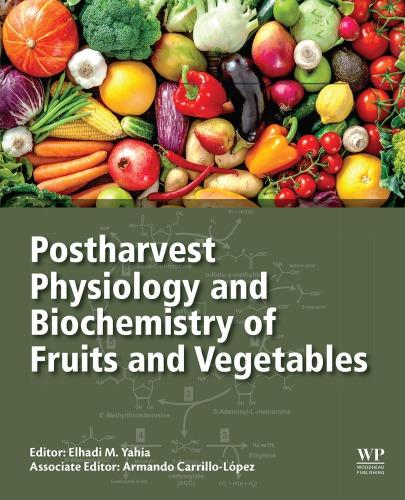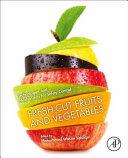CONTRIBUTORS
J.AbrahamDomı´nguez-Avila CoordinationofFoodTechnologyofPlantOrigin,CenterforResearchinFoodand Development,Hermosillo,Mexico
GhanShyamAbrol CollegeofHorticulture&Forestry,CentralAgricultureUniversity,Jhansi,India
A.Aguayo-Acosta DepartmentofBiologicalSciences,AutonomousUniversityofNuevoLeon,SanNicolas, Mexico
LuisM.Anaya-Esparza
FoodMicrobiologyLaboratory,DepartmentofAgriculturalandLivestockSciences,University ofGuadalajara,UniversityCenterofLosAltos,Tepatitla ´ ndeMorelos,Mexico
J.Angulo-Parra
SuperiorTechnologicalInstituteofGuasave,TecNM,Guasave,Mexico
BindviArora
DivisionofFoodScienceandPostharvestTechnology,ICAR-IndianAgriculturalResearch Institute,NewDelhi,India
VasudhaBansal
DepartmentofFoodEngineeringandNutrition,CenterofInnovativeandApplied Bioprocessing,Mohali,India
DavidF.Bridges
UnitedStatesDepartmentofAgriculture,AgriculturalResearchService,WesternRegional ResearchService,ProduceSafetyandMicrobiologyResearchUnit,Albany,CA,UnitedStates
AndreaCardosodeAquino
DepartmentofFoodEngineering,FederalUniversityofCeara,Fortaleza,Brazil
L.Coronado-Partida TechnologicalInstituteofTepic-TecNM,LIIA-BiotechnologyLaboratory,Tepic,Mexico
J.E.Da ´ vila-Avin ˜ a DepartmentofBiologicalSciences,AutonomousUniversityofNuevoLeon,SanNicolas, Mexico
LucianadeSiqueiraOliveira
DepartmentofFoodEngineering,FederalUniversityofCeara,Fortaleza,Brazil
NeeruDubey
AmityInternationalCenterforPostHarvestTechnology&ColdChainManagement,Amity University,Noida,India
KalianaSitonioEc ¸ a DepartmentofFoodEngineering,FederalUniversityofCeara,Fortaleza,Brazil
GustavoA.Gonza ´ lez-Aguilar
CoordinationofFoodTechnologyofPlantOrigin,CenterforResearchinFoodand Development,Hermosillo,Mexico
R.Gonza ´ lez-Estrada
TechnologicalInstituteofTepic-TecNM,LIIA-BiotechnologyLaboratory,Tepic,Mexico
GajananGundewadi
DivisionofPostHarvestTechnology,ICAR-IndianAgriculturalResearchInstitute,NewDelhi, India
P.Gutierrez-Martı ´ nez
TechnologicalInstituteofTepic-TecNM,LIIA-BiotechnologyLaboratory,Tepic,Mexico
RiadhIlahy
LaboratoryofHorticulture,NationalAgriculturalResearchInstituteofTunisia,Ariana, Tunisia
AlkaJoshi
DivisionofFoodScienceandPostharvestTechnology,ICAR-IndianAgriculturalResearch Institute,NewDelhi,India
VenkataSatishKuchi
DepartmentofPostharvestTechnology,CollegeofHorticulture,Dr.YSRHU,Anantharajupeta, India
DeepakMehta
DepartmentofFoodEngineeringandNutrition,CenterofInnovativeandApplied Bioprocessing,Mohali,India
VigyaMishra
DepartmentofPostHarvestTechnology,CollegeofHorticulture,BandaUniversityof Agriculture&Technology,Banda,India
EfigeniaMontalvo-Gonza ´ lez
IntegralLaboratoryofFoodResearch,TechnologicalInstituteofTepic,Tepic,Mexico
MahmoudrezaOvissipour
DepartmentofFoodScienceandTechnology,VirginiaPolytechnicInstituteandState University,Blacksburg;VirginiaSeafoodAREC,Hampton,VA,UnitedStates
AlemwatiPongener
ICAR-NationalResearchCentreonLitchi,Muzaffarpur,India
WFPC,LLC,UnitedStates.Consideringhisoutstandingcontributioninscienceand technology,hisbiographyhasbeenpublishedin“AsiaPacificWho’sWho,”Famous Nation:India’sWho’sWho,“TheHonoredBestCitizensofIndia,”andEmeraldWho’s WhoinAsia.
Dr.SiddiquiacquiredBSc(Agriculture)degreefromJawaharlalNehruKrishiVishwa Vidyalaya,Jabalpur,India.HereceivedMSc(Horticulture)andPhD(Horticulture) degreesfromBidhanChandraKrishiViswavidyalaya,Mohanpur,Nadia,Indiawithspecializationinthepostharvestbiotechnology.Hehasreceivedseveralgrantsfromvarious fundingagenciestocarryouthisresearchprojects.Heisdynamicallyindulgedinteaching (graduateanddoctoratestudents)andresearch,andhehasprovedhimselfasanactive scientistintheareaofpostharvestbiotechnology.
PREFACE
Globalfruitandvegetableproductionhasincreasedmanyfoldssincelastfewdecades.In spiteofincreasedproduction,wearestilllaggingbehindtoproperlyutilizetheproduce. Mostofthedevelopingcountriesarelosingupto30%–40%oftotalfruitandvegetable productionduetoinadequatepostharvesthandlingpractices.Thereareseveralfactors responsibleforhugepostharvestlossesincludingpoorpostharvestinfrastructuresuch asstorageandtransportationfacilities.Postharvestbioticandabioticstressescanaggravate theripening/senescenceresultingintheearlydecay.Bioticstressesincludinginfectionof bacteriaandfungusrendercommodityunsalable.Severalmicroorganismshavebeen identifiedcausinganumberofpostharvestdiseasesinfruitsandvegetables.
Irrespectiveofthecountries,thefarmersbelongtopoorandmiddleclassfamilies. Usingthemostsuccessfulandestablishedtechniquessuchascold/CAstoragearebeyond thecapacityofcommon/smallfarmers.Theyneedtohavesomecheapandeasytoapply technologieswithpracticalimplications.Besides,consumersareincreasinglyconcerned aboutthequalityandsafetyofproducetheybuy.Therefore,appropriateapproachesand technologiesareneededtoreducepostharvestmicrobialinfectionsassuringsafeproduce forhealthandenvironment.
Postharvestproducewashingandcleaninghavebeenwellstudiedtoavoid/reduce theincidenceofmicrobes.Washingistherecommendedpostharvestpracticebutit hasbeenreportedthatthewashingofproducewithsimplewaterresultsinfasterdeterioration.Variousnewtechnologiesincludingsanitizershavebeendevelopedforreducingthelevelsofmicroorganismsonsurfacesoffruitsandvegetableswhichareresponsible forpostharvestdiseasesandfoodborneillnesses.Inadditiontochlorination,disinfection offruitsandvegetablesusingozone,pulsedlight,irradiation,plasmatechnology,organic acid,hydrogenperoxide,hot/coldwater,electrolyzedwater,naturalantimicrobial agents,etc.,havebeendevelopedandsuggestedrecently,withoutaffectingthenatural quality.
Internationalmarketsgenerallyrejectshipmentsoffruitandvegetablescontaining unauthorizedpesticides,withchemicalresiduesexceedingpermissiblelimits,and/or withinadequatelabelingandpackaging.Postharvestmanagementtechnologiesdeterminefoodqualityandsafety,competitivenessinthemarket,andtheprofitsearnedby producers.
Thebook“PostharvestDisinfectionofFruitsandVegetables”willdeterminethe scopeofemergingeco-friendlytechnologiesdevelopedtoreducemicrobialinfection formaintainingthepostharvestqualityandsafety.Thebookcoversananalysisoftheseveralmethodologiespointingoutthesignificantadvantageandlimitationsofeach
Table1 Majorpostharvestdiseasesoffruitsandvegetablesandcausalagents
Nameofthe disease
CausalpathogenAffectedfruitsand vegetables
Anthracnose Colletotrichum gloeosporioides
Anthracnose crownrot
Colletotrichum musae
Bacterialsoftrot
Erwiniacarotovora
ssp. carotovora Erwinia spp.
Avocado,mango, banana,papaya, guava,citrusfruits, etc.
Reference(s)
Pruskyetal.(1983), Eckert(1977), Singh andThakur(2003), Robertetal.(2012), Limaetal.(2013), and Sellamuthuetal. (2013)
Banana
Bitterrot Colletotrichum gloeosporioides
Tomato,pepper, melon,squash, pumpkin, cucumber,cabbage, cauliflower,lettuce, celery,broccoli, spinach,asparagus, pea,bean,potato, sweetpotato,onion, garlic,etc.
Pomeandstonefruits
Eckert(1977,1990), SlabaughandGrove (1982),and Sakinah etal.(2013)
McDonaldetal. (1999), Falliketal. (2002), Phokum etal.(2006), Bhat etal.(2012)
EdneyandBurchill (1967), Janisiewicz etal.(2003),and Masoudetal.(2013)
C.fructicola Pear Lietal.(2013)
Blackheart,brown rot Fusarium moniliforme
Blacklesion,black rot
Blacklesion,dark spots
Stemphylium radicinum
Stemphylium botryosum
Blackpit Pseudomonas syringae
Blackrot Aspergillusniger
Banana,pineapple Barkai-Golan(2005)
Carrot
Pomefruits,papaya, grape,tomato, lettuce,etc.
Maude(1966)
DickensandEvans (1973), Sivanand Barkai-Golan (1976), BarkaiGolan(2005), Llorenteetal. (2010),and Toselli etal.(2012)
Citrusfruits Miriketal.(2005)
Dates,grape,tomato, melon,onion,garlic, etc.
Barkai-Golan(2005), Irkinand Korukluoglu(2007), Storarietal.(2012), and Ramı´rezetal. (2013)
Table1 Majorpostharvestdiseasesoffruitsandvegetablesandcausalagents cont’d
Nameofthe disease
Blackrot,stalkrot, crownrot,soft rot
CausalpathogenAffectedfruitsand vegetables
Ceratocystis paradoxa
Bluemold Penicillium expansum
Reference(s)
Banana,pineapple Jamaluddin(1979) and Yadahallietal. (2007)
Mainlypomeandstone fruits Barkai-Golan(2005), Palouetal.(2013), and Masoudetal. (2013)
Bluemold Penicilliumitalicum Mainlycitrusfruits Ramı´rezetal.(2013)
Brownrot Moniliniafructicola Mainlystonefruits Barkai-Golan(2005), Yinetal.(2013) ,and Sisquellaetal.(2013)
Brownrot Monilinialaxa Stoneaswellaspome fruits
Barkai-Golan(2005), ZhuandGuo (2010),and Marietta etal.(2012)
Brownrot Phytophthora citrophthora Citrusfruits Paneetal.(2001) and Vicentetal.(2012)
Bulbrot Pantoea agglomerans, P.ananatis,and P.allii
Onion Vahling-Armstrong etal.(2016)
Bull’seyerotof Neofabraea speciesApple Michaleckaetal. (2016)
Crownrot Fusarium pallidoroseum, Acremonium spp.
Banana
Barkai-Golan(2005), Uman ˜ a-Rojasand Garcı´a(2011),and Renganathanand Muthukumar(2012)
Crownrot,cigarendrot Verticillium theobromae Banana IgelekeandAyanru (2006)
Crownrot,finger rot,stalkrot stem-endrot
Botryodiplodia theobromae Banana,citrusfruits, avocado,mango, etc.
Dryorsoftrot Fusarium spp.Tomato,pepper, eggplant,squash, pumpkin, watermelon, cabbage,celery, artichoke,asparagus, corn,carrot,potato, sweetpotato,onion, garlic,etc.
Barkai-Golan(2005) and Renganathan andMuthukumar (2012)
Barkai-Golan(2005), Srirametal.(2010), Houetal.(2012), and Thuyetal. (2013)
Continued
typesofinjuriescanbesustainedbeforeandaftertheharvestofproduce.Injurycanbe causedbyweather,insects,birds,rodents,andfarmimplements.Injuriestofruitsusually occurwhentheproduceisdroppedontoahardsurface,before,during,orafterpacking, butinjuryisnotusuallyapparentimmediately.Later,bruisingmayalsotakeplace,butitis seenonlyexternally(e.g.,apples)oritmaybeevidentonlyonpeeling(e.g.,potatoes). Compressionbruisingmayresultfromtheoverstockingofbulkproduceinstorehouses orfromtheoverfillingofthepackaging(e.g.,grapes).Vibrationdamagecanoccur inunder-filledpacks,especiallyduringlongdistanceroadtransportation.Thedamaged produceisattackedbyvariousmicroorganisms,resultinginaprogressivedecay,which mayaffecttheentireproduce(Snowdon,1990).
3.THEINFECTIONPROCESS
Microorganismsinfecttheproduce,whilestillimmatureontheplant(preharvest infection)orduringharvestingandsubsequenthandlingandmarketingoperations(postharvestinfection).Thepostharvestinfectionprocessisgreatlyaidedbymechanical injuriestothepeeloftheproduce,suchas,fingernailscratchesandabrasions,roughhandling,insectpunctures,andcutstems.Theinfectionmayoccurbydirectpenetration ofthecuticleorentrythroughstomata,lenticels,wounds,orabscissionofscartissue. Furthermore,thephysiologicalconditionoftheproduce,thetemperature,andthe formationoftheperidermalsosignificantlyaffectresultingintwotypesofinfection,that is,preharvestinfectionandpostharvestinfection.
3.1PreharvestInfection
Preharvestinfectionoffruitsandvegetablesmayoccurthroughseveralavenues,suchas directpenetrationofthepeel,infectionthroughnaturalopeningsontheproduce,and infectionthroughthedamagedportion.Severaltypesofpathogenicfungiarecapable ofinitiatingtheinfectionprocessonthesurfaceoffloralparts,andonsound,developing fruits.Theinfectionisthenarrested,whichremainsquiescentuntilafterharvest,when theresistanceofthehostdecreasesandconditionsbecomefavorableforthegrowthof thepathogen,thatis,whenthefruitbeginstoripenoritstissuesbecomesenescent (Barkai-Golan,2005).Such“latentinfections”areimportantinthepostharvestwastage ofmanytropicalandsubtropicalfruits,suchasanthracnoseofmangoesandpapayas, crownrotofbananas,andstem-endrotofcitrus.Forexample,sporesof Colletotrichum germinateinmoistureonthesurfaceofthefruitandtheendofthegermtubeswells withinseveralhoursofgerminationandformsastructureknownasappressorium,which mayormaynotpenetratethefruitpeelbeforetheinfectionisarrested.
Weakparasiticfungiandbacteriamayalsogainaccesstoimmaturefruitsandvegetablesthroughnaturalopeningssuchasstomata,lenticels,andgrowthcracks.Again,this infectionmaynotdevelopuntilthehostbecomeslessresistanttotheinvadingorganism,
suchaswhenthefruitsripen.Itappearsthatsoundfruitsandvegetablescansuppressthe growthoftheseorganismsforaconsiderabletime(Barkai-Golan,2005).Forexample, sporesof Phlyctaenavagabunda penetrateapplelenticelsbeforeharvest,whichcausefruit rottingaroundthelenticelsinthestorage.
3.2PostharvestInfection
Manyfungithatcauseconsiderablewastageofproduceareunabletopenetratethe intactpeelofproduce,butreadilyinvadeviaanybreakpointinthepeel.Thedamage ismicroscopicbutissufficientforthepathogenspresentonthecroptogrowonit.In addition,thecutstemisafrequentpointofentryformicroorganismsandstem-endrots areimportantformsofpostharvestspoilageofmanyfruitsandvegetables(Barkai-Golan, 2005).Forexample,postharvestinfectionby Sclerotina and Colletotrichum isverycommon inmanyfruitsthroughdirectpenetrationofthepeel.
Theinfectionofpostharvestproduceiscausedbytheinfectiontothedifferentpartsof theplants,suchasfloralinfection,stem-endinfection,andquiescentinfection,whichare describedbelow.
3.2.1FloralInfection
Thereareseveralexamplesthatindicatethatinfectionbymicroorganismsoccursthrough floralpartsinmanyfruits.Forexample, Botrytiscinerea onblackcurrant(McNicoland Williamson,1988)andraspberry(DashwoodandFox,1988), Monilinialaxa onplums (SchagbauerandHolz,1990),and Lasiodiplodiatheobromae oncitrusfruits(Nadel, 1944; Minz,1946)infecttheproduceatfloralparts.Inanthracnoseofmango,anadditionalfruitinfectionmayarisefromquiescentinfectionsatthebaseoftheovary.
3.2.2Stem-EndInfection
Endophyticcolonizationoftheinflorescenceisanimportantmodeofinfectionforthe mangofruitcausedby Dothiorelladominicana ( Johnsonetal.,1992).Colonizationby stem-endrotfungi, L.theobromae and Phomopsiscitri,inthepeduncleandpedicelofcitrus fruitsisrestrictedbythewoundperidermandthecuticle.Thesefungidonotenterfruit untilabscissionoccurs.Postharvesttreatmentwiththegrowthhormone2,4-dichloro phenoxyaceticacid(2,4-D)wasthereforeintroducedtopreventabscissionofthebuttons (EckertandEaks,1989).
3.2.3QuiescentInfection
Thetimebetweeninitialinfectionandappearanceofdiseasesymptomsisknownas thelatentorquiescentperiod(BergerandBartz,1982; Swinburne,1983).Theterm “quiescent”referstoadormantparasiticrelationship,whichaftersometimechanges toanactiveone(Barkai-Golan,2005).Afungusmaybecomequiescentattheinitiation ofgermination,germtubeelongation,appressoriumformation,penetration,or
disease-resistance,havebeendevelopedtocontrolpostharvestdiseasesaswellasto increasethequalityandstoragelifeoffreshcommodities( JeongandJeong,2017).Synergisticeffectsofgammairradiationcombinedwithheattreatment(38°Cfor4days) contributedtothe5–10-foldincreaseintheinactivationofsporesofpostharvestpathogens(TemurandTiryaki,2013).Heattreatmentmayalsoaffectthesusceptibilityof thehosttopathogensbytriggeringthesynthesisofaninhibitorysubstanceinthepeel. Thecombinationofhotwaterandgammairradiationsynergisticallyreducedfungal developmentintomatofruits,resultingin1.7%and10.0%infectionratesby B.cinerea and Rhizopusstolonifer,respectively.Moreover,ahotwaterdip(HWD)followedbyirradiationat0.5kGytotallyeliminatedthedecaycausedby Alternariaalternata for8daysat23°Cinmangofruits(SpaldingandReeder,1986).However,thecombinationofhotwaterwithirradiationisnotcommonlyusedonfruitsduetothedetrimentaleffectithasonthequalityoftreatedclementinesandthecontradictoryresults presentedindifferentstudies(Brodricketal.,1976;Palouetal.,2007;Mahmoudetal., 2011).Anotherstudysuggestedthatacombinedtreatmentof0.5kGyofgammairradiationwithhotwater(47°Cfor7min)inactivates Penicilliumexpansum butdoesnot preventthegrowthof B.cinerea and Alternariatenuis.Inaddition,thefungalpopulation onmangoeswasreducedbytreatmentwithhotwater(55°Cfor5min)and1kGyof gammairradiation(El-Samahyetal.,2000).Asimilarstudyontomatofoundthatdecay causedby B.cinerea, R.stolonifer,and A.alternata isreducedwithacombinedtreatment of1kGyofgammairradiationandaHWDat50°Cfor2min(Barkai-Golan etal.,1993).
Palouetal.(2007) usedsodiumcarbonate,whichisanalternativetosyntheticfungicidestocontrolcitruspostharvestdiseasebecauseitisinexpensiveandcanbeusedwith aminimalriskofdamagetothefruits.AcombinationofsodiumcarbonatewithanX-ray irradiationdoseof0.875kGyismoreeffectiveincontrolling P.digitatum and Penicillium italicum comparedtoasingletreatment.Severalinvestigationshaveshowntheinhibitory natureofnanosilverparticles(NA)associatedwithsterilization(Kimetal.,2011; Jung etal.,2014).Gammairradiationshowednoantifungalactivityatadoseof1kGy,but incombinedtreatmentswithNAornanosizedsilicasilver(NSS)atconcentrationsabove 1 μgL 1,thesamedoseofgammaraysshowedthestrongestantifungalactivity.
Inaddition,astudyhassuggestedthatcombinationofirradiationwithcoldstorageis alsopromisingforthecontrolofpostharvestdiseases.Thegrowthof Colletotrichumacutatum onappleswasdramaticallyinhibitedwhengammairradiationwascombinedwith storageat0°Cfor4monthscomparedtothosestoredat20°C(Kimetal.,2011). Recently,astudydemonstratedthatthegerminationof P.expansum sporeswas completelyinhibitedwitha0.6kGydoseofgammarayswhencombinedwithstorage at1°C,withoutcausinganysignificantphysicalchangesinapples(Mostafavi etal.,2012).
5.1.2UseofLowTemperature
Useoflowtemperatureisconsideredveryimportantincontrollingdecayinseveralfruits andvegetables.Lowtemperaturemayslowdownthegrowthofthepathogens,butitalso slowsdownthefruitripeningprocess.Temperaturemanagementisimportantinreducingphysiologicaldeteriorationandpreventingmoisturelossandshrivelingaswellas reducingdiseaseincidence.Forthisreason,withmanycommoditiesrefrigerationcan beconsideredasupplementtofungicidaltreatmentsinseveralfruitsandvegetables (Barkai-Golan,2005).Between0and30°C,every10°Cincreaseintemperature increasesmetabolicactivitytwo-orthreefolds.Ingeneral,itisrecommendedtostore fruitsandvegetablesatthelowestpossibletemperaturethatdoesnotharmthehost.With manyfruitsandvegetables,thelowestdesirabletemperatureisjustabovethefreezing temperature.Certainvarietiesofapples,pears,plums,peaches,andgrapescanthus bestoredbetween0and 2°C.Itiscommonlyobservedthatapplesandpearsstored atslightlybelow0°Careattackedby B.cinerea, P.expansum,and Cladosporium.Thepathogenicgrowthofmostfungi,however,iscompletelystoppedattemperaturenear 0°C. Rhizopus spp.wasfoundtobehighlysusceptibletochillinginjurynear0°C (Barkai-Golan,2005).
Sincechillinginjuryisverycommonamongfruitsandvegetables,storageortransport ofthesecommoditiesmustbeathigherthan0°C.Certainvarietiesofapples,avocados, bananas,citrus,mangoes,papayas,andpineapplesaswellasmanyvegetables,particularly membersofSolanaceaeandCucurbitaceaeareinjuredbelow5°Cor10°C.Bananasare chilledattemperaturenear15°C.Inchillinginjuries,thetissuesturnbrownandsometimes diseaseresistanceisdecreased.Forexample, A.tenuis (McCollochandWorthington, 1952)and Geotrichumcandidum (Butler,1960)developreadilyduringripeningif mature-greentomatofruitsarepreviouslystoredbelowacriticaltemperaturebetween 5and10°C.Similarly, Segall(1967) reportedpostchillingsusceptibilityoftomatoesto Erwiniacaratovora and Aerobactercloaceae.However,itisapparentthattheeffectivenessof refrigerationislimitedby
(i) delayinheatremoval,
(ii) lackofadequaterefrigerationfacilities,
(iii) aneedtoremovethecommoditiesfromrefrigerationtocompletetheripening processinsomecases,
(iv) theinabilitytousethelowesttemperaturesbecausethecommoditiesaresusceptible tochillinginjury,and
(v) theabilityofsomepostharvestpathogenstogrowattemperaturesbelowthe freezingpointoffruitsandvegetables.
5.1.3HeatTreatmentoftheProduce
Theuseofheatforkillingpathogenicfungiisaveryoldconcept.Itwasfirstreportedfor thecontrolofdecayincitrusfruitsin1922(Fawcett,1922).Prestorageheattreatmentsto
Table3 Hotwatertreatmentsforcontrollingdecayinsomefruitsandvegetables cont’d
Fruitcrop Hotwaterdip Disease controlledPossibleinjuriesReferences
Pepper (bell) 531.5SoftrotSlightspotting Johnson (1968)
Potato57.520–30 – Ranganna etal. (1998)
Tomato39,4560minBacterialsoft rot – McDonald etal. (1999)
B.Hotwaterrinsingandbrushingtreatments
Apple5510sStoragerots – Maxinetal. (2012)
Grape fruit 59–6220sGreenmold – Poratetal. (2000b)
Kumquat5820GreenmoldDecay BenYehoshua etal. (2000)
Litchi5520s – Peelbrowning Lichteretal. (2000)
Mango46–6510–25Anthracnose – Ryoetal. (2012)
Melon5915 E.coli – Falliketal. (2000)
Orange5620sGreenmoldDecay Fatemiand Borji (2011)
Sweet pepper 5515Grayand Blackmold Decay incidence Falliketal. (1999)
Tangerine5620sGreenmold rot Surface wounding Poratetal. (2000a)
Tomato5215 Ilicetal. (2001) and Falliketal. (2002)
pointintreatingashort-lifecommoditywithafungicidethathasalongresidualactivity. Thesuccessofachemicaltreatmentfordiseasecontroldependsontheinitialsporeload, thedepthoftheinfectionwithinthehosttissues,thegrowthrateoftheinfection,the temperatureandhumidity,andthedepthtowhichthechemicalcanpenetratethehost









